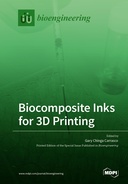Explore

Biocomposite Inks for 3D Printing
0 Ungluers have
Faved this Work
Login to Fave
Three-dimensional (3D) printing has evolved massively during the last years. The 3D printing technologies offer various advantages, including: i) tailor-made design, ii) rapid prototyping, and iii) manufacturing of complex structures. Importantly, 3D printing is currently finding its potential in tissue engineering, wound dressings, tissue models for drug testing, prosthesis, and biosensors, to name a few. One important factor is the optimized composition of inks that can facilitate the deposition of cells, fabrication of vascularized tissue and the structuring of complex constructs that are similar to functional organs. Biocomposite inks can include synthetic and natural polymers, such as poly (ε-caprolactone), polylactic acid, collagen, hyaluronic acid, alginate, nanocellulose, and may be complemented with cross-linkers to stabilize the constructs and with bioactive molecules to add functionality. Inks that contain living cells are referred to as bioinks and the process as 3D bioprinting. Some of the key aspects of the formulation of bioinks are, e.g., the tailoring of mechanical properties, biocompatibility and the rheological behavior of the ink which may affect the cell viability, proliferation, and cell differentiation.The current Special Issue emphasizes the bio-technological engineering of novel biocomposite inks for various 3D printing technologies, also considering important aspects in the production and use of bioinks.
This book is included in DOAB.
Why read this book? Have your say.
You must be logged in to comment.
